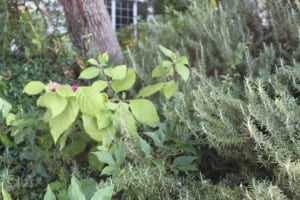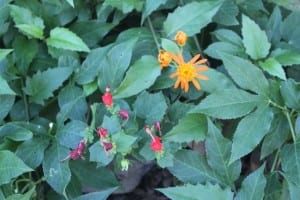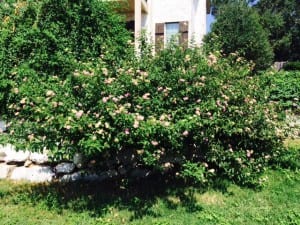I don’t know about you, but the temperatures have dipped just enough for me to want to get out and do some major gardening. The cooler fall weather is creeping in, albeit at a pretty slow pace, but it is definitely on its way. I have to admit that the past few months had sometimes made me shrink back and shudder when thinking of stepping outside in the heat to take care of my plants. The hot summer days are a big reminder why my plants and I are such big fans of drip irrigation, they still get the water they need and I don’t stand out in the sun sweltering with the hose. Anyhow, needless to say, I am one Happier Gardener now that I can see there is some relief in sight. When I finally ventured out to the garden to trim back some of my perennials to get them ready for another round of blooming, I realized that maybe I had cowered in my air conditioned home longer than I thought because I didn’t remember planting a few of the plants that were now in my yard. Don’t get me wrong, I was thrilled to find a few unexpected gifts tucked here and there in my landscape but I did scratch my head for a minute trying to think of why in the world I would have planted them in the location they were growing in? Peeking out from under a mass of passion vine were a few tiny red flowers shaped like little fez hats. I parted the vine a bit and could see plain as day that a little Turk’s cap plant was trying to make a home there. I walked to the front of my landscape and squished in between a rosemary plant and more passion vine was none other than an American beautyberry bush. It only had a few limbs but was already putting out the magenta-hued berries it is known for. As a bird swooped in for a berry treat, I was reminded that these plants weren’t deliberately planted in my garden by me, although it was possible, perhaps in a heat-induced, crazed state of mind. These plants were instead “gifted” to me from an outside source; perhaps a bird flying by depositing a seed after eating a berry, or maybe a great gust of wind blowing a dried seed from a spent flower. In times before, I’ve had veggies pop up in an otherwise unplanted garden plot just because I’ve put in some new compost to get ready for the season and a few wayward seeds must have been mixed into that compost. I seem to forget about these special gifts from time to time, but no complaints from me, I love these surprises.
(There it is….beautyberry popping up next to the rosemary. This one didn’t travel far, I have the original beautyberry about 20 feet away.)
These little “gifts” in the botanical world are called volunteer plants. And I happen to love that they are called that. It’s such a pleasant and delightful word in any sense. There has been no demanding or forcing of the seed to grow in a specific spot. It just landed, thought “Sure, this seems like a good place to stretch my legs out for awhile.”, then nestled in and started growing. Doesn’t that sound nice? The thing is, although it is nice to be given this free little plant, the plant doesn’t usually stay little. You may already have your landscape planned out and filled to the brim with not one inch to spare. I tend to be a bit of a “crowder” when it comes to spacing my plants, but even I draw the line at trying to allow a Turk’s cap to try and grow among passion vine that loves nothing more than to attach itself to other plants, climb up them and choke them out. Also, the volunteer plants don’t put any thought into their sunlight requirements before they plop down into the soil. How about that American beautyberry plant that has sprouted up right next to my rosemary? While my rosemary appreciates the full sun shining down on it, I know that the beautyberry would be happier with a little reprieve from the hot, afternoon sun. So what to do? I could leave them be and let nature take its course, allow the passionvine to engulf the Turk’s cap or the sun to wilt the beautyberry, but I am not one to look a gift horse in the mouth. I’ve been offered free plants and they will not go to waste. The only solution for me is to strip these plants of their volunteer status and employ them in a new location. Unfortunately I still have a space problem, as in no more space, but fortunately I have a brother-in-law who works for a school and will offer a home to any plant I give him. His motto is “If it’s free, it’s for me!”. This is a win-win situation because I get to save the plant and he gets to beautify his campus. If you have a volunteer sprout up in your landscape, I encourage you to find someone to give your volunteer a new home if you cannot. Ask around, not many people say no to free.
(Turks cap, passion vine, AND Mexican flame vine…..Houston, we have a problem! A crowding problem.)
Moving a volunteer plant is not a difficult task, but there are a few things to be mindful of to ensure success. First of all, you will want to try to dig up as much of the roots as possible. You are trying to get a wide enough circumference and a deep enough dig with your shovel so you create the least amount of damage and shock to the roots. Be mindful of your other plants that are around the area too, after all, they were there first. Next, go ahead and cut your volunteer back by about 1/2 to 2/3 its current size, or about the same size as your root ball. This will cause the plant’s energy to focus on its roots, which is what you want when transplanting. You want the roots to get established as quickly as possible as opposed to the energy of the plant being used to produce new leaves. It’s always best to replant your volunteer right away. Ideally you would have your new hole ready to plant your volunteer in at the same depth it’s currently at. Next you will want to do some or all of the following: add some agriform tablets which feed from the root up, apply some root stimulator (Fox Farm has a great product- Bush Doctor Kangaroots Root Drench), and/or use a good root-starting plant food (Espoma Bio-tone Starter Plus, or Fox Farm Jump Start fertilizer). All of these products will have your new transplant well on its way to thriving in its new home. You’ll want to make sure your plant is adequately watered while it is trying to get its roots established. Check on it from time to time by sticking your finger down into the soil to check for moisture. If you are unable to transplant your volunteer to its new location right away, like in my case with my brother-in-law taking the plants, be sure to immediately pot it up in some great soil (I love Fox Farm’s Happy Frog and Ocean Forest), still apply the root stimulator (use Kangaroots to keep the active soil microbes in your Fox Farm soil protected) and keep it watered and placed in correct growing conditions until you can get it to its new home.
(Fox Farm products are really amazing. This one will get those roots established in no time!)
There have been times in the past that I’ve allowed a volunteer plant to stay, undisturbed from day one and I have some beautiful, healthy lantana to prove it. I once nurtured a volunteer pumpkin plant that found its way into a flower border after a rollicking pumpkin carving party. Alas, the house painter squashed it with his ladder when trying to reach the top of our house. The pumpkin plant was in a really weird place anyway, but if I have the option of not disturbing the roots of any volunteer plant, that’s what I would choose first. But if space and/or a lack of healthy growing requirements are a problem, I choose to then carefully uproot the plant and find it a new home. I hope you will choose to do the same if you are blessed to receive one of these gifts from nature. You may have something sprout up in your lawn that you have never seen before. You might not even know if it is a valuable plant or a weed. Do me a favor and take a picture and bring it in or email it to us before you pluck it out. We should be able to identify it for you and tell you about its growing conditions and requirements and anything else you need to know about it. You may discover you have fallen in love with a new plant that has fallen into your lap. We hope you do!
(My volunteer lantana found the perfect spot! It nestled into a rock wall and gets plenty of sunshine!)
-The Happy Gardener
-Lisa Mulroy




